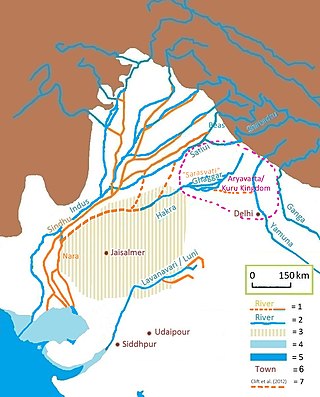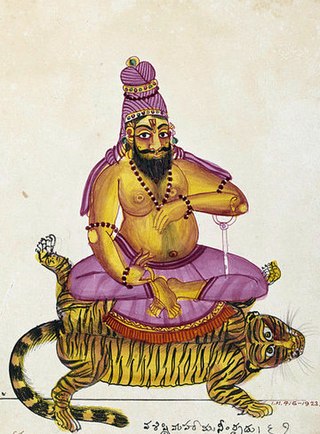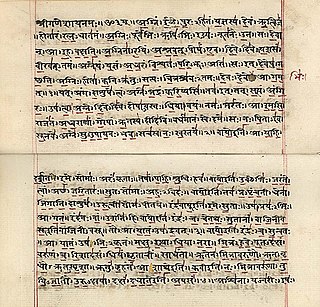
The Sarasvati River is a mythologized and deified ancient river first mentioned in the Rigveda and later in Vedic and post-Vedic texts. It played an important role in the Vedic religion, appearing in all but the fourth book of the Rigveda.

Atri or Attri is a Vedic sage, who is credited with composing numerous hymns to Agni, Indra, and other Vedic deities of Hinduism. Atri is one of the Saptarishi in the Hindu tradition, and the one most mentioned in its scripture Rigveda.

The historical Vedic religion, also known as Vedicism and Vedism, constituted the religious ideas and practices prevalent amongst the Indo-Aryan peoples of the northwest Indian subcontinent during the Vedic period. These ideas and practices are found in the Vedic texts, and some Vedic rituals are still practiced today. The Vedic religion is one of the major traditions which shaped Hinduism, though present-day Hinduism is significantly different from the historical Vedic religion.
Itihasa refers to the collection of written descriptions of important events in Hinduism. It includes the Mahabharata, the Puranas and the Ramayana. The Mahabharata includes the story of the Kurukshetra War and preserves the traditions of the Lunar dynasty in the form of embedded tales. The Puranas narrate universal history – the books discuss in depth the topics of cosmogony, myth, legend and history. The Ramayana contains the story of Rama and is incidentally related to the legends of the Solar dynasty. A story is considered to be itihasa only when the author of the story has himself witnessed or is part of the story. Vyasa, who wrote the Mahabharata, is himself a character in the story. Similarly, Valmiki, who wrote the Ramayana, was also a character in the story. Many classical Indian poets derive the plots of their poetry and drama from the Itihasa. The tradition of itihāsa is generally understood to be developed by the bardic tradition of Sūtas and Cāraṇas whose duties consisted of composing royal eulogies.

Panchala was an ancient kingdom of northern India, located in the Ganges-Yamuna Doab of the Upper Gangetic plain. During Late Vedic times, it was one of the most powerful states of ancient India, closely allied with the Kuru Kingdom. By the c. 5th century BCE, it had become an oligarchic confederacy, considered one of the solasa (sixteen) mahajanapadas of the Indian subcontinent. After being absorbed into the Mauryan Empire, Panchala regained its independence until it was annexed by the Gupta Empire in the 4th century CE.
Sudās Paijavana was an Indo-Aryan tribal king of the Bharatas, during the main or middle Rigvedic period. He led his tribe to victory in the Battle of the Ten Kings near the Paruṣṇī in Punjab, defeating an alliance of the powerful Puru tribe with other tribes, for which he was eulogized by his purohita Vashistha in a hymn of the Rigveda. His victory established the ascendency of the Bhārata clan, allowing them to move eastwards and settle in Kurukshetra, paving the way for the emergence of the Kuru "super-tribe" or tribal union, which dominated northern India in the subsequent period.

The Ashvins, also known as the Ashvini Kumaras and Asvinau, are Hindu twin gods associated with medicine, health, dawn, and the sciences. In the Rigveda, they are described as youthful divine twin horsemen, travelling in a chariot drawn by horses that are never weary, and portrayed as guardian deities that safeguard and rescue people by aiding them in various situations.

Kuru was a Vedic Indo-Aryan tribal union in northern Iron Age India, encompassing parts of the modern-day states of Haryana, Delhi, and some parts of western Uttar Pradesh, which appeared in the Middle Vedic period. The Kuru Kingdom was the first recorded state-level society in the Indian subcontinent.

Matsya was an ancient Indo-Aryan tribe of central South Asia whose existence is attested during the Iron Age. The members of the Matsya tribe were called the Mātsyeyas and were organised into a kingdom called the Matsya kingdom.

The Purus were a Rigvedic tribe or a confederation of tribes c. 1700–1400 BC. There were several factions of Purus, one being the Bharatas. The Purus and the Bharatas were the two most prominent tribes in most of the Rigveda. The Purus rallied many other groups against King Sudas of the Bharata, but were defeated in the Battle of the Ten Kings.
The seventh Mandala of the Rigveda has 104 hymns. In the Rigveda Anukramani, all hymns in this book are attributed to Vashista. Hymn 32 is additionally credited to Sakti Vashista, and hymns 101-102 are additionally credited to Kumara Agneya. It is one of the "family books", the oldest core of the Rigveda, which were composed in early vedic period.

Vasishtha is one of the oldest and revered Vedic rishis or sages, and one of the Saptarishis. Vasishtha is credited as the chief author of Mandala 7 of the Rigveda. Vasishtha and his family are mentioned in Rigvedic verse 10.167.4, other Rigvedic mandalas and in many Vedic texts. His ideas have been influential and he was called the first sage of the Vedanta school of Hindu philosophy by Adi Shankara.
The Battle of the Ten Kings first alluded to in the 7th Mandala of the Rigveda (RV), took place between a king of the Bharatas and a confederation of tribes. It resulted in a decisive victory for the Bharatas and subsequent formation of the Kuru polity. It is possible that the Battle of the Ten Kings, mentioned in the Rigveda, may have "formed the 'nucleus' of story" of the Kurukshetra War, though it was greatly expanded and modified in the Mahabharata's account. The term 'Mahabharata' itself implies a reference to this war through the prefix Maha- before Bharata i. e. – Great Bharatas or Victory to the Bharatas.
Divodāsa is a king in the Rigveda, the son of Vadhryashva RV 6.61.5. Further, the Mandala 9 of Rigveda mentions Divodasa thus: "[Indra] Smote swiftly forts, and Sambara, then Yadu and that Turvaga, for pious Divodasa's sake." RV 9.61.2.

Indigenous Aryanism, also known as the Indigenous Aryans theory (IAT) and the Out of India theory (OIT), is the conviction that the Aryans are indigenous to the Indian subcontinent, and that the Indo-European languages radiated out from a homeland in India into their present locations. It is a "religio-nationalistic" view on Indian history, and propagated as an alternative to the established migration model, which considers the Pontic–Caspian steppe to be the area of origin of the Indo-European languages.
Dadhikrā or Dadhikrāvan was likely the racehorse or warhorse selected for the Aśvamedha of King Trasadasyu, who ruled the Rigvedic Pūru tribe. Trasadasyu had led the Pūru eastward across the Indus river and there defeated the Anu-Druhyu and Yadu-Turvaśa tribal unions. The ritual would thus have been meant to strengthen Trasadasyu's royal legitimacy and signal the Pūru's newly preeminent position among the neighboring Aryan tribes.

The Vedic period, or the Vedic age, is the period in the late Bronze Age and early Iron Age of the history of India when the Vedic literature, including the Vedas, was composed in the northern Indian subcontinent, between the end of the urban Indus Valley Civilisation and a second urbanisation, which began in the central Indo-Gangetic Plain c. 600 BCE. The Vedas are liturgical texts which formed the basis of the influential Brahmanical ideology, which developed in the Kuru Kingdom, a tribal union of several Indo-Aryan tribes. The Vedas contain details of life during this period that have been interpreted to be historical and constitute the primary sources for understanding the period. These documents, alongside the corresponding archaeological record, allow for the evolution of the Indo-Aryan and Vedic culture to be traced and inferred.

The Rigveda or Rig Veda is an ancient Indian collection of Vedic Sanskrit hymns (sūktas). It is one of the four sacred canonical Hindu texts (śruti) known as the Vedas. Only one Shakha of the many survive today, namely the Śakalya Shakha. Much of the contents contained in the remaining Shakhas are now lost or are not available in the public forum. Rigveda Samhita was composed in the northwestern region of the Indian subcontinent.

The Puranic chronology is a timeline of Hindu mythology based on the Mahabharata, the Ramayana, and the Puranas. The central dates here are the Kurukshetra War and the Lanka War with the start of the start and end of the Kali Yuga and the other yugas and all the other events in Hindu mythology. The Puranic chronology is referred to by proponents of Indigenous Aryans to propose an earlier dating of the Vedic period, and the spread of Indo-European languages out of India, arguing that "the Indian civilization must be viewed as an unbroken tradition that goes back to the earliest period of the Sindhu-Sarasvati Valley traditions ."












